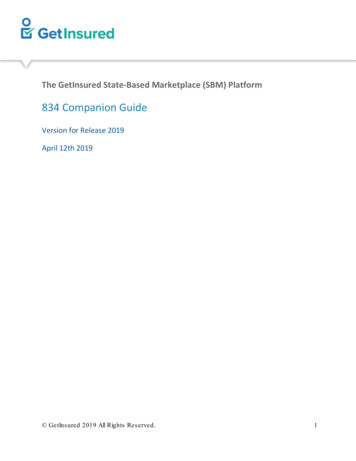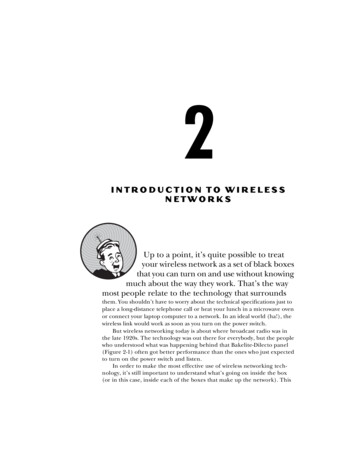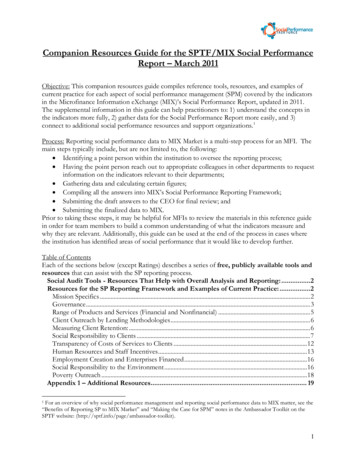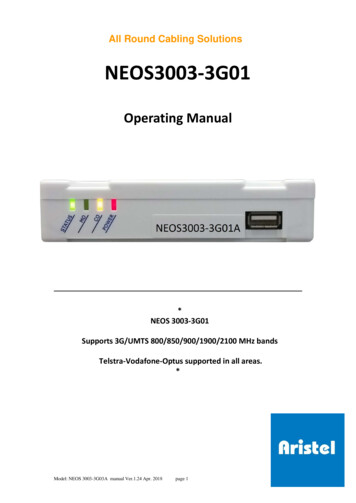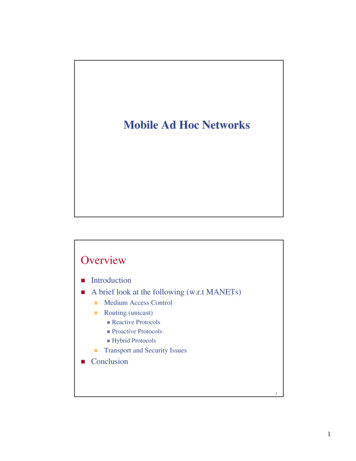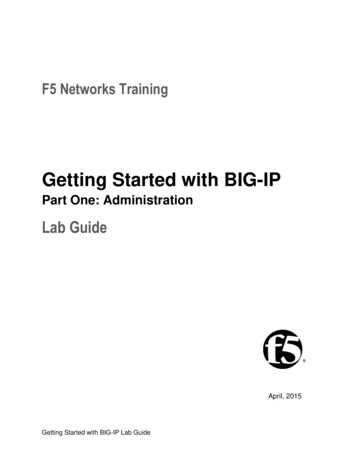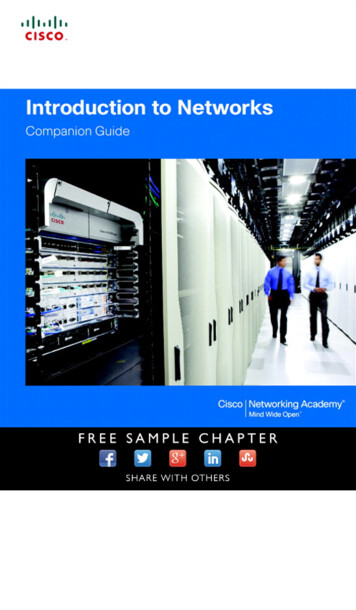
Transcription
Introduction to NetworksCompanion GuideCisco Networking AcademyCisco Press800 East 96th StreetIndianapolis, Indiana 46240 USA
iiIntroduction to Networks Companion GuideCisco Networking AcademyPublisherPaul BogerCopyright 2014 Cisco Systems, Inc.Published by:Cisco Press800 East 96th StreetIndianapolis, IN 46240 USAAll rights reserved. No part of this book may be reproduced or transmitted in any formor by any means, electronic or mechanical, including photocopying, recording, or byany information storage and retrieval system, without written permission from the publisher, except for the inclusion of brief quotations in a review.Printed in the United States of AmericaFirst Printing December 2013Library of Congress Cataloging-in-Publication data is on file.ISBN-13: 978-1-58713-316-9ISBN-10: 1-58713-316-4Warning and DisclaimerThis book is designed to provide information about the Cisco Networking AcademyIntroduction to Networks course. Every effort has been made to make this book ascomplete and as accurate as possible, but no warranty or fitness is implied.The information is provided on an “as is” basis. The authors, Cisco Press, and CiscoSystems, Inc. shall have neither liability nor responsibility to any person or entity withrespect to any loss or damages arising from the information contained in this book orfrom the use of the discs or programs that may accompany it.The opinions expressed in this book belong to the author and are not necessarily thoseof Cisco Systems, Inc.Associate PublisherDave DusthimerBusiness OperationManager, Cisco PressJan CornelssenExecutive EditorMary Beth RayManaging EditorSandra SchroederDevelopment EditorEllie C. BruProject EditorMandie FrankCopy EditorJohn EdwardsTechnical EditorAubrey AdamsEditorial AssistantVanessa EvansDesignerMark ShirarCompositionStudio Galou, LLCIndexerLarry SweazyProofreaderDebbie Williams
iiiTrademark AcknowledgementsAll terms mentioned in this book that are known to be trademarks or service marks have been appropriately capitalized. Cisco Press or Cisco Systems, Inc., cannot attest to the accuracy of this information. Use of a term in thisbook should not be regarded as affecting the validity of any trademark or service mark.Corporate and Government SalesThe publisher offers excellent discounts on this book when ordered in quantity for bulk purchases or special sales,which may include electronic versions and/or custom covers and content particular to your business, training goals,marketing focus, and branding interests. For more information, please contact:U.S. Corporate and Government or sales outside the United States, please contact:International Salesinternational@pearsoned.comFeedback InformationAt Cisco Press, our goal is to create in-depth technical books of the highest quality and value. Each book is craftedwith care and precision, undergoing rigorous development that involves the unique expertise of members from theprofessional technical community.Readers’ feedback is a natural continuation of this process. If you have any comments regarding how we couldimprove the quality of this book, or otherwise alter it to better suit your needs, you can contact us through email atfeedback@ciscopress.com. Please make sure to include the book title and ISBN in your message.We greatly appreciate your assistance.
ivIntroduction to Networks Companion GuideAbout the Contributing AuthorsMark A. DyeMark is the lead network engineer for Kwajalein Range Services at Ronald ReaganBallistic Missile Defense Test Site on Kwajalein, Marshall Islands. He is responsiblefor the network team that provides design, deployment, and operation of all themissile test range data networks across ten islands as well as three continental U.S.locations.He has previously worked as subject matter expert and content team lead for theCisco Academy Program as well as an author for multiple Cisco Network AcademyFundamentals online courses. He worked to develop and review courseware andassessments for both the Academy and certification programs.For more than 20 years, Mark served as technology manager for The Bevill Centerfor Advanced Manufacturing Technology of Alabama Technology Network. Hedeveloped and implemented comprehensive network strategies for intranet andInternet, including policies, administrative procedures, network security, andinterconnectivity. He also implemented and taught Cisco Networking AcademyFundamentals of Wireless LANs, Fundamentals of Network Security, and CCNAand CCNP courses at The Bevill Center for instructors and students.Allan D. ReidAllan is a professor and program supervisor at Centennial College in Toronto,Ontario, Canada, where he teaches courses in networking, network security, virtualization, and cloud computing. He is the lead for the Centennial College ASC/ITCand has been teaching the academy curriculum since one of the earliest versions.Allan has authored multiple books and online courses for the Cisco Academy program, where he is a subject matter expert and content team lead. He works as part ofthe core team to develop state-of-the-art assessments and courseware.Outside of his academic responsibilities, Allan has been active in the computer andnetworking fields for more than 30 years and is currently a principal in a companyinvolved in the design, installation, and management of network solutions for smallto medium-sized companies.
vContents at a GlanceIntroductionxxviChapter 1:Exploring the NetworkChapter 2:Configuring a Network Operating System59Chapter 3:Network Protocols and Communications115Chapter 4:Network AccessChapter 5:EthernetChapter 6:Network LayerChapter 7:Transport LayerChapter 8:IP AddressingChapter 9:Subnetting IP NetworksChapter 10:Application LayerChapter 11:It’s a NetworkAppendix A:Answers to the “Check Your Understanding” 551627
viIntroduction to Networks Companion GuideContentsIntroductionxxviChapter 1Exploring the NetworkObjectives1Key Terms1Introduction (1.0.1.1)13Globally Connected (1.1)4Networking Today (1.1.1) 4Networks in Our Daily Lives (1.1.1.1) 4Technology Then and Now (1.1.1.2) 5The Global Community (1.1.1.3) 6Networks Support the Way We Learn (1.1.1.4) 7Networks Support the Way We Communicate (1.1.1.5)Networks Support the Way We Work (1.1.1.6) 10Networks Support the Way We Play (1.1.1.7) 10Providing Resources in a Network (1.1.2) 11Networks of Many Sizes (1.1.2.1) 12Clients and Servers (1.1.2.2, 1.1.2.3) 13Peer-to-Peer (1.1.2.4) 13LANs, WANs, and the Internet (1.2)14Components of a Network (1.2.1, 1.2.1.1) 15End Devices (1.2.1.2) 16Intermediary Network Devices (1.2.1.3) 16Network Media (1.2.1.4) 17Network Representations (1.2.1.5) 18Topology Diagrams (1.2.1.6) 19LANs and WANs (1.2.2) 21Types of Networks (1.2.2.1) 21Local-Area Networks (1.2.2.2) 22Wide-Area Networks (1.2.2.3) 22The Internet (1.2.3, 1.2.3.1) 22Intranet and Extranet (1.2.3.2) 23Internet Access Technologies (1.2.4.1) 25Connecting Remote Users to the Internet (1.2.4.2) 25Connecting Businesses to the Internet (1.2.4.3) 27The Network as a Platform (1.3)28The Converging Network (1.3.1.1)Planning for the Future (1.3.1.2)29308
viiThe Supporting Network Architecture (1.3.2.1)31Fault Tolerance in Circuit-Switched Networks (1.3.2.2) 32Fault Tolerance 32Circuit-Switched Connection-Oriented Networks 33Fault Tolerance in Packet-Switched Networks (1.3.2.3) 34Packet-Switched Networks 34Scalable Networks (1.3.2.4) 35Scalability 35Providing QoS (1.3.2.5) 37Quality of Service 37Providing Network Security (1.3.2.6) 39Security 39The Changing Network Environment (1.4)41Network Trends (1.4.1) 41New Trends (1.4.1.1) 41Bring Your Own Device (BYOD) (1.4.1.2) 43Online Collaboration (1.4.1.3) 43Video Communication (1.4.1.4) 44Cloud Computing (1.4.1.5) 46Data Centers (1.4.1.6) 47Technology Trends in the Home (1.4.2.1) 48Powerline Networking (1.4.2.2)49Wireless Broadband (1.4.2.3) 50Wireless Internet Service Provider (WISP)Wireless Broadband Service 50Security Threats (1.4.3.1) 50Security Solutions (1.4.3.2)51Cisco Network Architectures (1.4.4.1)CCNA (1.4.4.2)53Summary (1.5)54Practice55Class ActivitiesLabsChapter 2525555Packet Tracer Activities55Check Your Understanding56Configuring a Network Operating SystemObjectives59Key Terms595950
viiiIntroduction to Networks Companion GuideIntroduction (2.0.1)60Introduction to Cisco IOS (2.0.1.1)IOS Boot Camp (2.1)6061Cisco IOS (2.1.1) 61Operating Systems (2.1.1.1) 61Purpose of OS (2.1.1.2) 63Location of the Cisco IOS (2.1.1.3) 63IOS Functions (2.1.1.4) 64Accessing a Cisco IOS Device (2.1.2) 65Console Access Method (2.1.2.1) 65Telnet, SSH, and AUX Access Methods (2.1.2.2) 66Terminal Emulation Programs (2.1.2.3) 67Navigating the IOS (2.1.3) 67Cisco IOS Modes of Operation (2.1.3.1) 68Primary Modes (2.1.3.2) 69Global Configuration Mode and Submodes (2.1.3.3) 69Navigating Between IOS Modes (2.1.3.4, 2.1.3.5) 71The Command Structure (2.1.4) 72IOS Command Structure (2.1.4.1) 73Cisco IOS Command Reference (2.1.4.2) 75Context-Sensitive Help (2.1.4.3) 76Command Syntax Check (2.1.4.4) 78Hot Keys and Shortcuts (2.1.4.5) 79IOS Examination Commands (2.1.4.6) 83The show version Command (2.1.4.7) 83Getting Basic (2.2)86Host Names (2.2.1) 86Why the Switch (2.2.1.1) 86Device Names (2.2.1.2) 87Host Names (2.2.1.3) 87Configuring Host Names (2.2.1.4) 88Limiting Access to Device Configurations (2.2.2) 89Securing Device Access (2.2.2.1) 89Securing Privileged EXEC Access (2.2.2.2) 90Securing User EXEC Access (2.2.2.3) 91Encrypting Password Display (2.2.2.4) 92Banner Messages (2.2.2.5) 94Saving Configurations (2.2.3) 96Configuration Files (2.2.3.1) 96Capturing Text (2.2.3.2) 98Address Schemes (2.3)100Ports and Addresses (2.3.1) 100
ixIP Addressing of Devices (2.3.1.1) 100Interfaces and Ports (2.3.1.2) 101Addressing Devices (2.3.2) 102Configuring a Switch Virtual Interface (2.3.2.1) 102Manual IP Address Configuration for End Devices(2.3.2.2) 103Automatic IP Address Configuration for End Devices(2.3.2.3) 104IP Address Conflicts (2.3.2.4) 105Verifying Connectivity (2.3.3) 106Test the Loopback Address on an End Device (2.3.3.1)Testing the Interface Assignment (2.3.3.2) 107Testing End-to-End Connectivity (2.3.3.3) 108Summary (2.4)Practice109110Class ActivitiesLabsChapter 3110111Packet Tracer Activities111Check Your Understanding111Network Protocols and CommunicationsObjectives115Key Terms115Introduction (3.0.1.1)115116Rules of Communication (3.1)116The Rules (3.1.1) 117What Is Communication? (3.1.1.1) 117Establishing the Rules (3.1.1.2) 118Message Encoding (3.1.1.3) 119Message Formatting and Encapsulation (3.1.1.4)Message Size (3.1.1.5) 121Message Timing (3.1.1.6) 121Message Delivery Options (3.1.1.7) 122Network Protocols and Standards (3.2)123Protocols (3.2.1) 123Protocols: Rules That Govern Communications(3.2.1.1) 123Network Protocols (3.2.1.2) 124Interaction of Protocols (3.2.1.3) 125120106
xIntroduction to Networks Companion GuideProtocol Suites (3.2.2) 127Protocol Suites and Industry Standards (3.2.2.1) 127Creation of the Internet and Development of TCP/IP(3.2.2.2) 128TCP/IP Protocol Suite and Communication Process(3.2.2.3) 129Standards Organizations (3.2.3) 133Open Standards (3.2.3.1) 133ISOC, IAB, and IETF (3.2.3.2) 134IEEE (3.2.3.3) 135ISO (3.2.3.4) 136Other Standards Organizations (3.2.3.5) 136Reference Models (3.2.4) 137The Benefits of Using a Layered Model (3.2.4.1) 138The OSI Reference Model (3.2.4.2) 139The TCP/IP Protocol Model (3.2.4.3) 140Comparing the OSI Model with the TCP/IP Model(3.2.4.4) 141Moving Data in the Network (3.3)143Data Encapsulation (3.3.1) 143Communicating the Messages (3.3.1.1) 143Protocol Data Units (PDU) (3.3.1.2) 144Encapsulation (3.3.1.3) 145Deencapsulation (3.3.1.4) 146Accessing Local Resources (3.3.2) 146Network Addresses and Data-Link Addresses (3.3.2.1)Communicating with a Device on the Same Network(3.3.2.2) 148MAC and IP Addresses (3.3.2.3) 149Accessing Remote Resources (3.3.3) 150Default Gateway (3.3.3.1) 150Communicating with a Device on a Remote Network(3.3.3.2) 151Summary (3.4)Practice154155Class ActivitiesLabs155155Packet Tracer Activities155Check Your Understanding156146
xiChapter 4Network AccessObjectives161Key Terms161161Introduction (4.0.1.1)163Physical Layer Protocols (4.1)164Getting It Connected (4.1.1) 164Connecting to the Network (4.1.1.1) 164Network Interface Cards (4.1.1.2) 165Purpose of the Physical Layer (4.1.2) 166The Physical Layer (4.1.2.1) 166Physical Layer Media (4.1.2.2) 167Physical Layer Standards (4.1.2.3) 168Fundamental Principles of Layer 1 (4.1.3) 169Physical Layer Fundamental Principles (4.1.3.1)Bandwidth (4.1.3.2) 171Throughput (4.1.3.3) 172Types of Physical Media (4.1.3.4) 173Network Media (4.2)173Copper Cabling (4.2.1) 173Characteristics of Copper Media (4.2.1.1) 173Copper Media (4.2.1.2) 175Unshielded Twisted-Pair Cable (4.2.1.3) 176Shielded Twisted-Pair (STP) Cable (4.2.1.4) 176Coaxial Cable (4.2.1.5) 177Copper Media Safety (4.2.1.6) 178UTP Cabling (4.2.2) 179Properties of UTP Cabling (4.2.2.1) 179UTP Cabling Standards (4.2.2.2) 180UTP Connectors (4.2.2.3) 182Types of UTP Cable (4.2.2.4) 183Testing UTP Cables (4.2.2.5) 185Fiber-Optic Cabling (4.2.3) 185Properties of Fiber-Optic Cabling (4.2.3.1) 185Fiber Media Cable Design (4.2.3.2) 186Types of Fiber Media (4.2.3.3) 187Network Fiber Connectors (4.2.3.4) 189Testing Fiber Cables (4.2.3.5) 191Fiber Versus Copper (4.2.3.6) 192Wireless Media (4.2.4) 193Properties of Wireless Media (4.2.4.1) 193Types of Wireless Media (4.2.4.2) 194169
xiiIntroduction to Networks Companion GuideWireless LAN (4.2.4.3) 196802.11 Wi-Fi Standards (4.2.4.4)Data Link Layer Protocols (4.3)196198Purpose of the Data Link Layer (4.3.1) 198The Data Link Layer (4.3.1.1) 198Data Link Sublayers (4.3.1.2) 199Media Access Control (4.3.1.3) 200Providing Access to Media (4.3.1.4) 201Layer 2 Frame Structure (4.3.2) 202Formatting Data for Transmission (4.3.2.1)Creating a Frame (4.3.2.2) 203Layer 2 Standards (4.3.3) 204Data Link Layer Standards (4.3.3.1) 204Media Access Control (4.4)202205Topologies (4.4.1) 206Controlling Access to the Media (4.4.1.1) 206Physical and Logical Topologies (4.4.1.2) 207WAN Topologies (4.4.2) 208Common Physical WAN Topologies (4.4.2.1) 208Physical Point-to-Point Topology (4.4.2.2) 209Logical Point-to-Point Topology (4.4.2.3) 209Half and Full Duplex (4.4.2.4) 210LAN Topologies (4.4.3) 210Physical LAN Topologies (4.4.3.1) 210Logical Topology for Shared Media (4.4.3.2) 211Contention-Based Access (4.4.3.3) 212Multiaccess Topology (4.4.3.4) 213Controlled Access (4.4.3.5) 213Ring Topology (4.4.3.6) 214Data-Link Frame (4.4.4) 215The Frame (4.4.4.1) 215The Header (4.4.4.2) 215Layer 2 Address (4.4.4.3) 216The Trailer (4.4.4.4) 217LAN and WAN Frames (4.4.4.5) 218Ethernet Frame (4.4.4.6) 220PPP Frame (4.4.4.7) 221802.11 Wireless Frame (4.4.4.8) 222Summary (4.5)225
xiiiPractice227Class ActivitiesLabsChapter 5227227Packet Tracer Activities227Check Your Understanding227Ethernet231Objectives231Key Terms231Introduction (5.0.1.1)Ethernet Protocol (5.1)233234Ethernet Operation (5.1.1) 234LLC and MAC Sublayers (5.1.1.1) 235MAC Sublayer (5.1.1.2) 235Media Access Control (5.1.1.3) 236MAC Address: Ethernet Identity (5.1.1.4) 238Frame Processing (5.1.1.5) 239Ethernet Frame Attributes (5.1.2) 240Ethernet Encapsulation (5.1.2.1) 241Ethernet Frame Size (5.1.2.2) 242Introduction to the Ethernet Frame (5.1.2.3) 243Ethernet MAC (5.1.3) 244MAC Addresses and Hexadecimal (5.1.3.1) 244MAC Address Representations (5.1.3.2) 246Unicast MAC Address (5.1.3.3) 247Broadcast MAC Address (5.1.3.4) 248Multicast MAC Address (5.1.3.5) 248MAC and IP (5.1.4, 5.1.4.1) 249End-to-End Connectivity, MAC, and IP (5.1.4.2) 250Address Resolution Protocol (5.2, 5.2.1, 5.2.1.1)252ARP Functions (5.2.1.2) 252ARP Operation (5.2.1.3) 253ARP Role in Remote Communication (5.2.1.4) 256Removing Entries from an ARP Table (5.2.1.5) 258ARP Tables on Networking Devices (5.2.1.6) 258ARP Issues (5.2.2) 259How ARP Can Create Problems (5.2.2.1) 259Mitigating ARP Problems (5.2.2.2) 260
xivIntroduction to Networks Companion GuideLAN Switches (5.3) 260Switching (5.3.1) 260Switch Port Fundamentals (5.3.1.1) 261Switch MAC Address Table (5.3.1.2) 261Duplex Settings (5.3.1.3) 263Auto-MDIX (5.3.1.4) 265Frame-Forwarding Methods on Cisco Switches(5.3.1.5) 265Cut-Through Switching (5.3.1.6) 266Memory Buffering on Switches (5.3.1.8) 267Fixed or Modular (5.3.2) 268Fixed Versus Modular Configuration (5.3.2.1) 268Module Options for Cisco Switch Slots (5.3.2.2) 270Layer 3 Switching (5.3.3) 272Layer 2 Versus Layer 3 Switching (5.3.3.1) 272Cisco Express Forwarding (5.3.3.2) 273Types of Layer 3 Interfaces (5.3.3.3) 274Configuring a Routed Port on a Layer 3 Switch(5.3.3.4) 275Summary (5.4)Practice277278Class ActivitiesLabsChapter 6278279Packet Tracer Activities279Check Your Understanding279Network LayerObjectives283Key Terms283283Introduction (6.0.1.1)284Network Layer Protocols (6.1)285Network Layer in Communication (6.1.1) 285The Network Layer (6.1.1.1) 285Network Layer Protocols (6.1.1.2) 286Characteristics of the IP Protocol (6.1.2) 287Characteristics of IP (6.1.2.1) 287IP—Connectionless (6.1.2.2) 288IP—Best-Effort Delivery (6.1.2.3) 288IP—Media Independent (6.1.2.4) 289Encapsulating IP (6.1.2.5) 290
xvIPv4 Packet (6.1.3) 291IPv4 Packet Header (6.1.3.1) 291IPv4 Header Fields (6.1.3.2) 293Sample IPv4 Headers (6.1.3.3) 293IPv6 Packet (6.1.4) 295Limitations of IPv4 (6.1.4.1) 295Introducing IPv6 (6.1.4.2) 296Encapsulating IPv6 (6.1.4.3) 297IPv6 Packet Header (6.1.4.4) 298Sample IPv6 Header (6.1.4.5) 298Routing (6.2)299How a Host Routes (6.2.1) 299Host Forwarding Decision (6.2.1.1) 300Default Gateway (6.2.1.2) 300IPv4 Host Routing Table (6.2.1.3) 301IPv4 Host Routing Entries (6.2.1.4) 303Sample IPv4 Host Routing Table (6.2.1.5) 305Sample IPv6 Host Routing Table (6.2.1.6) 306Router Routing Tables (6.2.2) 307Router Packet-Forwarding Decision (6.2.2.1) 307IPv4 Router Routing Table (6.2.2.2) 308Directly Connected Routing Table Entries (6.2.2.3) 310Remote Network Routing Table Entries (6.2.2.4) 311Next-Hop Address (6.2.2.5) 312Sample Router IPv4 Routing Table (6.2.2.6) 312Routers (6.3)315Anatomy of a Router (6.3.1) 315A Router Is a Computer (6.3.1.1) 315Router CPU and OS (6.3.1.2) 315Router Memory (6.3.1.3) 316Inside a Router (6.3.1.4) 318Router Backplane (6.3.1.5) 319Connecting to a Router (6.3.1.6) 320LAN and WAN Interfaces (6.3.1.7) 321Router Bootup (6.3.2) 322Cisco IOS (6.3.2.1) 322Bootset Files (6.3.2.2) 323Router Bootup Process (6.3.2.3) 323Show Version Output (6.3.2.4) 325Configuring a Cisco Router (6.4)326Configure Initial Settings (6.4.1) 326Router Configuration Steps (6.4.1.1)326
xviIntroduction to Networks Companion GuideConfigure Interfaces (6.4.2) 328Configure LAN Interfaces (6.4.2.1) 328Verify Interface Configuration (6.4.2.2) 330Configuring the Default Gateway (6.4.3) 332Default Gateway on a Host (6.4.3.1) 332Default Gateway on a Switch (6.4.3.2) 333Summary (6.5)Practice335336Class ActivitiesLabsChapter 7337337Packet Tracer Activities337Check Your Understanding337Transport LayerObjectives341Key Terms341341Introduction (7.0.1.1)342Learning Objectives342Transport Layer Protocols (7.1)343Transportation of Data (7.1.1) 343Role of the Transport Layer (7.1.1.1, 7.1.1.2) 343Conversation Multiplexing (7.1.1.3) 347Transport Layer Reliability (7.1.1.4) 347TCP (7.1.1.5) 348UDP (7.1.1.6) 349The Right Transport Layer Protocol for the RightApplication (7.1.1.7) 350Introducing TCP and UDP (7.1.2) 352Introducing TCP (7.1.2.1) 352Role of TCP (7.1.2.2) 353Introducing UDP (7.1.2.3) 355Role of UDP (7.1.2.4) 355Separating Multiple Communications (7.1.2.5) 356TCP and UDP Port Addressing (7.1.2.6 – 7.1.2.9) 357TCP and UDP Segmentation (7.1.2.10) 362TCP and UDP (7.2)363TCP Communication (7.2.1) 364TCP Reliable Delivery (7.2.1.1) 364TCP Server Processes (7.2.1.2) 364
xviiTCP Connection Establishment and Termination(7.2.1.3) 365TCP Three-Way Handshake Analysis—Step 1(7.2.1.4) 367TCP Three-Way Handshake Analysis—Step 2(7.2.1.5) 368TCP Three-Way Handshake Analysis—Step 3(7.2.1.6) 369TCP Session Termination Analysis (7.2.1.7) 370Reliability and Flow Control (7.2.2) 373TCP Reliability—Ordered Delivery (7.2.2.1) 373TCP Reliability—Acknowledgement andWindow Size (7.2.2.2) 374TCP Reliability—Data Loss and Retransmission(7.2.2.3) 376TCP Flow Control—Window Size andAcknowledgements (7.2.2.4) 376TCP Flow Control—Congestion Avoidance (7.2.2.5) 378UDP Communication (7.2.3) 379UDP Low Overhead Versus Reliability (7.2.3.1) 379UDP Datagram Reassembly (7.2.3.2) 380UDP Server Processes and Requests (7.2.3.3) 381UDP Client Processes (7.2.3.4) 381TCP or UDP, That Is the Question (7.2.4) 382Applications That Use TCP (7.2.4.1) 382Applications That Use UDP (7.2.4.2) 382Summary (7.3)Practice384386Class ActivitiesLabsChapter 8386386Packet Tracer Activities386Check Your Understanding386IP AddressingObjectives391Key Terms391391Introduction (8.0.1.1)393IPv4 Network Addresses (8.1)393IPv4 Address Structure (8.1.1) 394Binary Notation (8.1.1.1) 394Binary Number System (8.1.1.2)395
xviiiIntroduction to Networks Companion GuideConverting a Binary Address to Decimal (8.1.1.3) 397Converting from Decimal to Binary (8.1.1.5, 8.1.1.6) 399IPv4 Subnet Mask (8.1.2) 400Network Portion and Host Portion of an IPv4 Address(8.1.2.1) 400Examining the Prefix Length (8.1.2.2) 402IPv4 Network, Host, and Broadcast Addresses(8.1.2.3) 403First Host and Last Host Addresses (8.1.2.4) 405Bitwise AND Operation (8.1.2.5) 406Importance of ANDing (8.1.2.6) 407IPv4 Unicast, Broadcast, and Multicast (8.1.3) 408Assigning a Static IPv4 Address to a Host (8.1.3.1) 408Assigning a Dynamic IPv4 Address to a Host (8.1.3.2) 409Unicast Transmission (8.1.3.3) 410Broadcast Transmission (8.1.3.4) 412Multicast Transmission (8.1.3.5) 413Types of IPv4 Addresses (8.1.4) 416Public and Private IPv4 Addresses (8.1.4.1) 416Special-Use IPv4 Addresses (8.1.4.3) 417Legacy Classful Addressing (8.1.4.4) 419Assignment of IP Addresses (8.1.4.5, 8.1.4.6) 422IPv6 Network Addresses (8.2)424IPv4 Issues (8.2.1) 424The Need for IPv6 (8.2.1.1) 425IPv4 and IPv6 Coexistence (8.2.1.2) 426IPv6 Addressing (8.2.2) 427Hexadecimal Number System (8.2.2.1) 427IPv6 Address Representation (8.2.2.2) 429Rule 1: Omit Leading 0s (8.2.2.3) 430Rule 2: Omit All 0 Segments (8.2.2.4) 430Types of IPv6 Addresses (8.2.3) 431IPv6 Address Types (8.2.3.1) 431IPv6 Prefix Length (8.2.3.2) 432IPv6 Unicast Addresses (8.2.3.3) 432IPv6 Link-Local Unicast Addresses (8.2.3.4) 434IPv6 Unicast Addresses (8.2.4) 435Structure of an IPv6 Global Unicast Address (8.2.4.1)Static Configuration of a Global Unicast Address(8.2.4.2) 437Dynamic Configuration of a Global Unicast AddressUsing SLAAC (8.2.4.3) 439435
xixDynamic Configuration of a Global Unicast AddressUsing DHCPv6 (8.2.4.4) 441EUI-64 Process or Randomly Generated (8.2.4.5) 442Dynamic Link-Local Addresses (8.2.4.6) 444Static Link-Local Addresses (8.2.4.7) 445Verifying IPv6 Address Configuration (8.2.4.8) 447IPv6 Multicast Addresses (8.2.5) 449Assigned IPv6 Multicast Addresses (8.2.5.1) 449Solicited-Node IPv6 Multicast Addresses (8.2.5.2) 450Connectivity Verification (8.3)451ICMP (8.3.1) 451ICMPv4 and ICMPv6 Messages (8.3.1.1) 451ICMPv6 Router Solicitation and Router AdvertisementMessages (8.3.1.2) 453ICMPv6 Neighbor Solicitation and NeighborAdvertisement Messages (8.3.1.3) 454Testing and Verification (8.3.2) 455Ping: Testing the Local Stack (8.3.2.1) 455Ping: Testing Connectivity to the Local LAN (8.3.2.2) 456Ping: Testing Connectivity to Remote (8.3.2.3) 456Traceroute: Testing the Path (8.3.2.4) 456Summary (8.4)Practice460461Class ActivitiesLabsChapter 9462462Packet Tracer Activities462Check Your Understanding462Subnetting IP Networks465Objectives465Key Terms465Introduction (9.0.1.1)466Subnetting an IPv4 Network (9.1)467Network Segmentation (9.1.1) 467Reasons for Subnetting (9.1.1.1) 467Communication Between Subnets (9.1.1.2) 468IP Subnetting Is FUNdamental (9.1.2) 468The Plan (9.1.2.1) 468The Plan: Address Assignment (9.1.2.2) 470
xxIntroduction to Networks Companion GuideSubnetting an IPv4 Network (9.1.3) 470Basic Subnetting (9.1.3.1) 470Subnets in Use (9.1.3.2) 472Subnetting Formulas (9.1.3.3) 474Creating Four Subnets (9.1.3.4) 475Creating Eight Subnets (9.1.3.5) 478Creating 100 Subnets with a /16 prefix (9.1.3.10) 481Calculating the Hosts (9.1.3.11) 483Calculating the Hosts (9.1.3.12) 484Determining the Subnet Mask (9.1.4) 487Subnetting Based on Host Requirements (9.1.4.1) 487Subnetting Network-Based Requirements (9.1.4.2) 488Subnetting to Meet Network Requirements (9.1.4.3,9.1.4.4) 488Benefits of Variable-Length Subnet Masking (9.1.5) 492Traditional Subnetting Wastes Addresses (9.1.5.1) 492Variable-Length Subnet Masks (VLSM) (9.1.5.2) 493Basic VLSM (9.1.5.3) 494VLSM in Practice (9.1.5.4) 495VLSM Chart (9.1.5.5) 496Addressing Schemes (9.2)498Structured Design (9.2.1) 498Planning to Address the Network (9.2.1.1) 498Assigning Addresses to Devices (9.2.1.2) 499Design Considerations for IPv6 (9.3)501Subnetting an IPv6 Network (9.3.1) 501Subnetting Using the Subnet ID (9.3.1.1) 502IPv6 Subnet Allocation (9.3.1.2) 503Subnetting into the Interface ID (9.3.1.3) 505Summary (9.4)Practice507508Class ActivitiesLabsChapter 10508509Packet Tracer Activities509Check Your Understanding509Application LayerObjectives515Key Terms515515Introduction (10.0.1.1)516
xxiApplication Layer Protocols (10.1)517Application, Session, and Presentation (10.1.1) 517OSI and TCP/IP Models Revisited (10.1.1.1) 517Application Layer (10.1.1.2) 518Presentation and Session Layers (10.1.1.3) 518TCP/IP Application Layer Protocols (10.1.1.4) 519How Application Protocols Interact with End-User Applications(10.1.2) 520Peer-to-Peer Networks (10.1.2.1) 520Peer-to-Peer Applications (10.1.2.2) 521Common P2P Applications (10.1.2.3) 522Client-Server Model (10.1.2.5) 523Well-Known Application Layer Protocols and Services (10.2)525Common Application Layer Protocols (10.2.1) 525Application Layer Protocols Revisited (10.2.1.1) 525Hypertext Transfer Protocol and Hypertext MarkupLanguage (10.2.1.2) 525HTTP and HTTPS (10.2.1.3) 526SMTP, POP, and IMAP (10.2.1.4-10.2.1.7) 527Providing IP Addressing Services (10.2.2) 530Domain Name System (10.2.2.1) 530DNS Message Format (10.2.2.2) 530DNS Hierarchy (10.2.2.3) 532Nslookup (10.2.2.4) 533Dynamic Host Configuration Protocol (10.2.2.6) 534DHCPv4 Operation (10.2.2.7) 535Providing File-Sharing Services (10.2.3) 538File Transfer Protocol (10.2.3.1) 538Server Message Block (10.2.3.4) 539The Message Heard Around the World (10.3)540Move It! (10.3.1) 540The Internet of Things (10.3.1.1) 540Message Travels Through a Network (10.3.1.2) 540Getting the Data to the End Device (10.3.1.3) 542Getting the Data Through the Internetwork (10.3.1.4) 542Getting the Data to the Right Application (10.3.1.5) 543Warriors of the Net (10.3.1.6) 545Summary (10.4)546
xxiiIntroduction to Networks Companion GuidePractice548Class ActivitiesLabsChapter 11548548Packet Tracer Activities548Check Your Understanding549It’s a NetworkObjectives551Key Terms551551Introduction (11.0.1.1)Create and Grow (11.1)552553Devices in a Small Network (11.1.1) 553Small-Network Topologies (11.1.1.1) 553Device Selection for a Small Network (11.1.1.2) 554IP Addressing for a Small Network (11.1.1.3) 555Redundancy in a Small Network (11.1.1.4) 556Design Considerations for a Small Network (11.1.1.5) 557Protocols in a Small Network (11.1.2) 559Common Applications in a Small Network (11.1.2.1) 559Common Protocols in a Small Network (11.1.2.2) 560Real-Time Applications for a Small Network(11.1.2.3) 561Growing to Larger Networks (11.1.3) 562Scaling a Small Network (11.1.3.1) 562Protocol Analysis of a Small Network (11.1.3.2) 563Evolving Protocol Requirements (11.1.3.3) 564Keeping the Network Safe (11.2)564Network Device Security Measures (11.2.1) 565Categories of Threats to Network Security (11.2.1.1) 565Physical Security (11.2.1.2) 566Types of Security Vulnerabilities (11.2.1.3) 566Vulnerabilities and Network Attacks (11.2.2) 569Viruses, Worms, and Trojan Horses (11.2.2.1) 569Reconnaissance Attacks (11.2.2.2) 570Access Attacks (11.2.2.3) 570DoS Attacks (11.2.2.4) 572Mitigating Network Attacks (11.2.3) 574Backup, Upgrade, Update, and Patch (11.2.3.1) 574Authentication, Authorization, and Accounting(11.2.3.2) 575
xxiiiFirewalls (11.2.3.3) 577Endpoint Security (11.2.3.4) 578Securing Devices (11.2.4) 578Introduction to Securing Devices (11.2.4.1)Passwords (11.2.4.2) 579Basic Security Practices (11.2.4.3) 580Enable SSH (11.2.4.4) 581Basic Network Performance (11.3)578583Ping (11.3.1) 583Interpreting Ping Results (11.3.1.1) 583Extended Ping (11.3.1.2) 585Network Baseline (11.3.1.3) 586Tracert (11.3.2) 587Interpreting Tracert Messages (11.3.2.1) 587Show Commands (11.3.3) 588Common Show Commands Revisited (11.3.3.1) 588Viewing Router Settings with the show version Command(11.3.3.2) 593Viewing Switch Settings with the show versionCommand (11.3.3.3) 595Host and IOS Commands (11.3.4) 595ipconfig Command Options (11.3.4.1) 595arp Command Options (11.3.4.2) 597show cdp neighbors Command Options (11.3.4.3) 597Using the show ip interface brief Command (11.3.4.4) 600Managing IOS Configuration Files (11.4)603Router and Switch File Systems (11.4.1) 603Router File Systems (11.4.1.1) 603Switch File Systems (11.4.1.2) 606Back Up and Restore Configuration Files (11.4.2) 607Backing Up and Restoring Using Text Files (11.4.2.1) 607Backing Up and Restoring Using TFTP (11.4.2.2) 608Using USB Ports on a Cisco Router (11.4.2.3) 609Backing Up and Restoring Using a USB Flash Drive(11.4.2.4) 610Integrated Routing Services (11.5)611Integrated Router (11.5.1) 611Multifunction Device (11.5.1.1) 611Types of Integrated Routers (11.5.1.2) 613Wireless Capability (11.5.1.3) 614Basic Security of Wireless (11.5.1.4) 615
xxivIntroduction to Networks Companion Gui
vi Introduction to Networks Companion Guide Contents Introduction xxvi Chapter 1 Exploring the Network 1 Objectives 1 Key Terms 1 Introduction (1.0.1.1) 3 Globally Connected (1.1) 4 Networking Today (1.1.1) 4 Networks in Our Daily Lives (1.1.1.1) 4 Technology Then and Now (1.1.1.2) 5 The Global Community (1.1.1.3) 6




